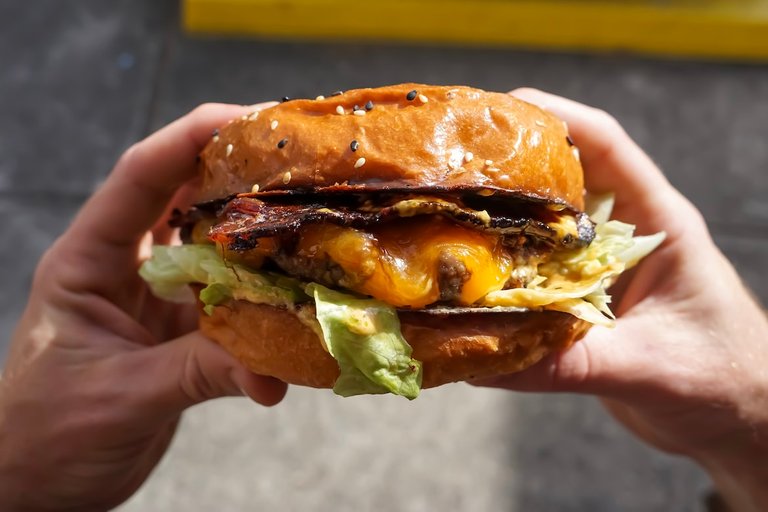Empacho: Causes and Treatment.
Hello hive community, today I am going to talk about "empacho" or indigestion.
Bloating is a term used to describe an upset stomach that can be caused by a variety of factors, including overeating, eating fatty or spicy foods, or even stress. Symptoms may include abdominal pain, nausea, vomiting, diarrhea, and a general feeling of being unwell. In this four page guide, we will discuss the causes of indigestion and the available treatments.
It can be caused by a variety of factors, such as overconsumption of food, especially fatty or spicy foods, which can irritate the stomach lining and cause inflammation. Stress and anxiety can also contribute to indigestion, as they can affect digestion and cause an upset stomach. Other factors that can contribute to indigestion include the consumption of contaminated food, the excessive use of medications, and gastrointestinal disorders such as gastritis.
Treatment of empacho depends on the underlying cause. If the binge is caused by overeating, it may help to take a meal break and allow your stomach to recover. Drinking liquids such as water or herbal tea can also help relieve symptoms of intoxication. If symptoms persist, over-the-counter medications such as antacids can be taken to help reduce inflammation and ease stomach upset. If the indigestion is caused by a bacterial infection, it may be necessary to take antibiotics. In severe cases, hospital treatment may be needed.
To prevent binge eating, it's important to avoid overeating and choose healthy foods that are easy to digest, such as fruits, vegetables, and lean proteins. It is also important to avoid foods that can irritate the stomach lining, such as fatty and spicy foods, and to avoid excessive alcohol consumption. Reducing stress and anxiety can also help prevent nausea, so it's important to take steps to manage stress, such as exercising regularly, practicing meditation or yoga, and talking to a therapist if needed.
• Physiopathology:
The pathophysiology of indigestion involves several physiological processes in the gastrointestinal tract that can trigger the symptoms of indigestion. The main physiological processes involved in empacho are described below:
Digestion and absorption of food: The digestion process begins in the mouth and continues in the stomach and small intestine. During this process, food is broken down into smaller components, such as proteins, carbohydrates, and fats, which are then absorbed by the body. If a large amount of food is consumed, the digestion and absorption process may be affected, which can lead to an upset stomach and other symptoms.
Gastrointestinal Motility: Gastrointestinal motility refers to the coordinated movement of the muscles of the gastrointestinal tract that help propel food through the digestive tract. If gastrointestinal motility is compromised, food can remain in the stomach for an extended period of time, which can lead to stomach upset and other symptoms.
Release of gastric juices: The stomach produces gastric juices, such as hydrochloric acid and digestive enzymes, which help in the digestion of food. If an excessive amount of gastric juices is produced, this can lead to irritation of the stomach lining and cause an upset stomach.
Gastrointestinal inflammation: Gastrointestinal inflammation can be caused by a variety of factors, such as bacterial or viral infection, food intolerance, or overuse of medications. Inflammation can cause abdominal pain, nausea, vomiting, and diarrhea.
• Function of the vagus nerve in indigestion
The vagus nerve is one of the most important cranial nerves in the human body, and it plays a crucial role in the functioning of the parasympathetic nervous system. This nerve is responsible for transmitting signals from the brain to the internal organs of the body, including the stomach, small intestine, and colon.
In indigestion, the vagus nerve may play an important role in regulating gastrointestinal movement and motility, as well as in stomach acid production. When the vagus nerve is not working properly, there can be a decrease in gastrointestinal motility, which can lead to a buildup of food in the stomach and a feeling of fullness. Also, a decrease in the activity of the vagus nerve can cause a decrease in the production of acid in the stomach, which can lead to a burning sensation in the chest and other symptoms of indigestion.
In addition, vagus nerve stimulation has been shown to improve gastrointestinal motility and reduce symptoms of indigestion in some patients. This is achieved by activating the parasympathetic nervous system, which helps relax the muscles of the gastrointestinal tract and improve motility.
Indigestion is an upset stomach that can be caused by a variety of factors, including overeating, stress, and gastrointestinal disorders. Your treatment depends on the underlying cause and may include measures such as taking a meal break, drinking fluids, and taking over-the-counter or prescription medications. To prevent it, it is important to choose healthy foods, avoid irritating foods, and reduce stress and anxiety.
Thanks for reading me!
Informative References:
•La indigestión, también llamada dispepsia o malestar estomacal.
• ¿Qué es un empacho? Síntomas y remedios caseros más efectivos.
Text translated with Google Translate.
Banner created in Canva.

Empacho: Causas y Tratamiento.
Hola comunidad de hive hoy les voy a hablar sobre el "empacho " o indigestión.
El empacho es un término utilizado para describir un malestar estomacal que puede ser causado por una variedad de factores, como comer en exceso, comer alimentos grasos o picantes, o incluso el estrés. Los síntomas pueden incluir dolor abdominal, náuseas, vómitos, diarrea y una sensación general de malestar. En esta guía de cuatro páginas, discutiremos las causas del empacho y los tratamientos disponibles.
Puede ser causado por una variedad de factores, como el consumo excesivo de alimentos, especialmente alimentos grasos o picantes, que pueden irritar el revestimiento del estómago y causar inflamación. El estrés y la ansiedad también pueden contribuir al empacho, ya que pueden afectar la digestión y provocar malestar estomacal. Otros factores que pueden contribuir al empacho incluyen el consumo de alimentos contaminados, el uso excesivo de medicamentos, y trastornos gastrointestinales como la gastritis.
El tratamiento del empacho depende de la causa subyacente. Si el empacho es causado por el consumo excesivo de alimentos, puede ser útil hacer una pausa en la comida y permitir que el estómago se recupere. Beber líquidos como agua o té de hierbas también puede ayudar a aliviar los síntomas del empacho. Si los síntomas persisten, se pueden tomar medicamentos de venta libre como los antiácidos para ayudar a reducir la inflamación y aliviar el malestar estomacal.
Si el empacho es causado por una infección bacteriana, puede ser necesario tomar antibióticos. En casos graves, se puede necesitar tratamiento hospitalario.
Para prevenir el empacho, es importante evitar comer en exceso y elegir alimentos saludables que sean fáciles de digerir, como frutas, verduras y proteínas magras. También es importante evitar alimentos que puedan irritar el revestimiento del estómago, como los alimentos grasos y picantes, y evitar el consumo excesivo de alcohol. La reducción del estrés y la ansiedad también puede ayudar a prevenir el empacho, por lo que es importante tomar medidas para controlar el estrés, como hacer ejercicio regularmente, practicar la meditación o el yoga, y hablar con un terapeuta si es necesario.
• Fisiopatologia :
La fisiopatología del empacho implica varios procesos fisiológicos en el tracto gastrointestinal que pueden desencadenar los síntomas del empacho. A continuación, se describen los principales procesos fisiológicos involucrados en el empacho:
Digestión y absorción de alimentos: El proceso de la digestión comienza en la boca y continúa en el estómago e intestino delgado. Durante este proceso, los alimentos se descomponen en componentes más pequeños, como proteínas, carbohidratos y grasas, que luego son absorbidos por el cuerpo. Si se consume una gran cantidad de alimentos, el proceso de digestión y absorción puede verse afectado, lo que puede provocar malestar estomacal y otros síntomas.
Motilidad gastrointestinal: La motilidad gastrointestinal se refiere al movimiento coordinado de los músculos del tracto gastrointestinal que ayudan a impulsar los alimentos a través del tracto digestivo. Si la motilidad gastrointestinal se ve comprometida, los alimentos pueden permanecer en el estómago durante un período prolongado de tiempo, lo que puede provocar malestar estomacal y otros síntomas.
Liberación de jugos gástricos: El estómago produce jugos gástricos, como ácido clorhídrico y enzimas digestivas, que ayudan en la digestión de los alimentos. Si se produce una cantidad excesiva de jugos gástricos, esto puede provocar irritación del revestimiento del estómago y causar malestar estomacal.
Inflamación gastrointestinal: La inflamación gastrointestinal puede ser causada por una variedad de factores, como la infección bacteriana o viral, la intolerancia alimentaria o el uso excesivo de medicamentos. La inflamación puede provocar dolor abdominal, náuseas, vómitos y diarrea.
• Funcion del nervio vago en la indigestion
El nervio vago es uno de los nervios craneales más importantes en el cuerpo humano, y desempeña un papel crucial en el funcionamiento del sistema nervioso parasimpático. Este nervio es responsable de transmitir señales desde el cerebro hasta los órganos internos del cuerpo, incluyendo el estómago, el intestino delgado y el colon.
En la indigestión, el nervio vago puede desempeñar un papel importante en la regulación del movimiento y la motilidad gastrointestinal, así como en la producción de ácido en el estómago. Cuando el nervio vago no funciona adecuadamente, puede haber una disminución en la motilidad gastrointestinal, lo que puede provocar una acumulación de alimentos en el estómago y una sensación de plenitud. Además, una disminución en la actividad del nervio vago puede provocar una disminución en la producción de ácido en el estómago, lo que puede provocar una sensación de ardor en el pecho y otros síntomas de indigestión.
Además, se ha demostrado que la estimulación del nervio vago puede mejorar la motilidad gastrointestinal y reducir los síntomas de indigestión en algunos pacientes. Esto se logra mediante la activación del sistema nervioso parasimpático, que ayuda a relajar los músculos del tracto gastrointestinal y mejorar la motilidad.
El empacho es un malestar estomacal que puede ser causado por una variedad de factores, incluyendo el consumo excesivo de alimentos, el estrés y los trastornos gastrointestinales. Su tratamiento depende de la causa subyacente y puede incluir medidas como hacer una pausa en la comida, beber líquidos y tomar medicamentos de venta libre o prescritos. Para prevenirlo es importante elegir alimentos saludables, evitar alimentos irritantes y reducir el estrés y la ansiedad.
Gracias por leerme!
Referencias Informativas:
•La indigestión, también llamada dispepsia o malestar estomacal.
• ¿Qué es un empacho? Síntomas y remedios caseros más efectivos.
Texto traducido con Google Translate.
Banner creado en Canva.








